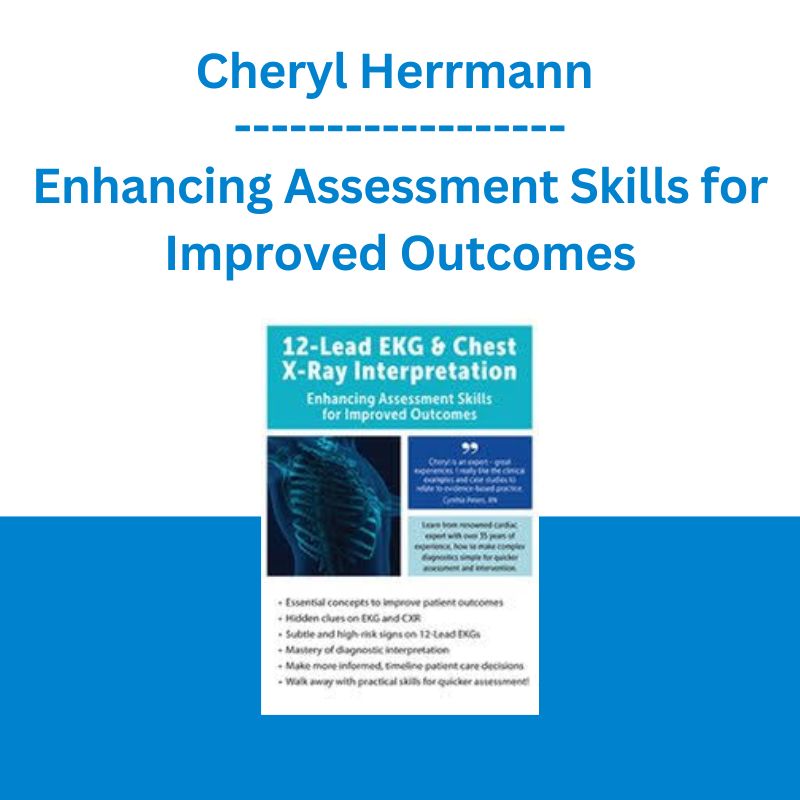*** Proof of Product ***

Exploring the Essential Features of “Cheryl Herrmann – 12-Lead EKG & Chest X-Ray Interpretation: Enhancing Assessment Skills for Improved Outcomes”
When to be concerned — 12-Lead EKG Pearls of Wisdom
In a cardiac event, the clock starts ticking as soon as the coronary artery becomes occluded. Are you ready to rapidly interpret STEMI (ST segment elevation myocardial infarction) changes with a 12-lead EKG and provide effective intervention to reduce the size of the AMI? The 12-lead EKG is one of the most frequently utilized cardiac assessment tools to assess chest pain. Yet, it provides us with so much more information that can help improve patient care. The purpose of this portion of the recording is to assist the health care professional in mastering 12-lead EKG assessment skills in order to identify the common and not-so-common changes. You will also examine subtle and high-risk signs on 12-Lead EKG that are of concern preoperatively, in the ED, or in the clinic.
As Easy as Black and White…
Chest X-rays are also a commonly ordered diagnostic test, yet viewing and interpreting them can be challenging. Chest X-rays can be as simple as black and white. The purpose of this portion of the recording is to provide clinicians with chest X-ray interpretation skills in order to help you easily assess changes in the patient’s condition. You will develop skills in line identification; differentiations among atelectasis, pneumonia, ARDS, pleural effusion, and pulmonary edema; and identification of pneumothorax, cardiac tamponade, and cardiomyopathy. You will view examples of numerous chest X-rays to reinforce the concepts presented. Clinicians will walk away from this session with practical skills for better, quicker patient assessment allowing for more effective intervention.
Speaker
Cheryl Herrmann, RN, MS, APRN, CCRN, CCNS-CSC/CMC, has 40+years of nursing experience – 15 years as a bedside nurse in critical care and 25 + years as a cardiac clinical nurse specialist. In her career, she has assessed and managed cardiology, cardiovascular surgery and critical care patients from the prehospital setting as PHRN on the ambulance to patients in cardiac progressive and critical care units. As CNS, she helped develop the Rapid Response Team and Protocols at her institution and was chairman of the RRT committee to analyze and improve outcomes. One of the creative teaching methods to improve outcomes was being involved in biyearly “Preventing a Crisis” sessions for acute care nurses that utilized recent case studies to discern strategies to prevent the crisis. Cheryl has a passion for cardiac nursing and is an advocate for empowering nurses to become experts.
She is a popular presenter for national conferences including the American Association of Critical Care Nurses NTI. Cheryl has been honored with the American Association of Critical Care Nurses Circle of Excellence – Excellent Clinical Nurse Specialist Award.
Speaker Disclosures:
Financial: Cheryl Herrmann has employment relationships with Carle Health Greater Peoria and Liberty University. She receives a speaking honorarium and recording royalties from PESI, Inc. She has no relevant financial relationships with ineligible organizations.
Non-financial: Cheryl Herrmann is a member of the Heart of Illinois AACN, the Illinois Society of Advanced Practice Nurses, the National AACN, and the National Association of Clinical Nurse Specialists.
Objectives
- Review normal 12-Lead EKG and the polarity of each lead
- Identify axis deviation and implication in clinical practice
- Discuss the criteria, causes, and significance of left and right bundle branch blocks
- Analyze EKG changes associated with ischemia, injury, and infarction patterns
- Develop a quick approach to diagnosis of STEMI on 12-lead EKG
- Analyze EKGs for subtle and high-risk signs
- Develop a systematic approach to chest X-ray interpretation
- Identify correct placement of common invasive lines on chest X-rays
- Differentiate between common cardiac and pulmonary disorders on chest X-rays
- Discover the clinical pearls of EKG and chest X-rays in challenging case studies
Outline
PART I: THE ABCS OF 12-LEAD EKG INTERPRETATION
12-Lead EKG 101
- Cardiac electrical conduction system
- Electrical vectors
Introduction to the 12-leadsLimb leads
Augmented leads
Chest leads - Normal polarity and P-QRS-T configuration of each lead
Ace the Axis
- Left and right axis deviation
- Causes and criteria of axis deviation
- Methods to determine axis deviation
- Case presentations, analysis, and clinical application
Beat the Bundles
- Right and left bundle branch blocks (BBB)
- Criteria for right vs. left BBB
- Causes and complications of right and left BBB
- Left anterior and left posterior hemiblocks
- Case presentations, analysis, and clinical application
Correlate the Coronary Anatomy
- Coronary arteries
Right coronary artery (RCA)
Left coronary artery (LCA)
Left anterior descending artery (LAD)
Circumflex artery (CX) - Posterior descending artery (PDA)
- Left ventricular walls
Inferior
Anterior
Septal
Lateral
Posterior - Relationship of coronary arteries and ventricular walls to the 12-leads
Inferior—RCA—leads II, III, AVF
Anterior/septal—LAD—leads V1–V4
Lateral—circumflex—leads I, AVL, V5, V6
Posterior—PDA—reciprocal changes V1–V4
Differential Diagnosis: 12-Lead EKG in Acute Coronary Syndrome
- Ischemia pattern
- Injury pattern
- Infarction pattern
- Reciprocal changes
- ST segment elevation myocardial infarction (STEMI)
- Non-ST segment elevation myocardial infarction (NSTEMI)
- Coronary spasm
- Takotsubo cardiomyopathy (broken heart syndrome)
Example and Analysis Time – Piecing It All Together
- 30-second diagnosis of STEMI on 12-lead EKG
- Coronary angiographic correlation to 12-lead EKG
- Case presentations, analysis, and clinical application
Advanced 12-Lead: Challenging Clinical Presentations
- Atrial and ventricular hypertrophy
- Wolff-Parkinson-White syndrome
- Prolonged QT intervals
PART II: CHEST X-RAY INTERPRETATION – AS EASY AS BLACK AND WHITE
Note: Most chest X-ray examples will be AP films
Chest X-ray basics
- Technique
- Black and white principles
- Projections
Anterior-posterior (AP)
Posterior-anterior (PA)
Lateral
Systematic Approach
- Bone structures
- Intercostal spaces
- Soft tissues
- Lungs/trachea/pulmonary vasculature
- Pleural surfaces
- Diaphragm
- Mediastinum
- Heart and great vessels
- Invasive lines
As Easy as Black
- Pneumothorax
- Subcutaneous emphysema
- Clinical application and treatment
As Easy as White
- Pleural effusion
- Pulmonary edema
- Pneumonia
- Atelectasis
- Acute respiratory distress syndrome (ARDS)
- Cardiomyopathy
- Pericardial effusion
- Cardiac tamponade
- Clinical application and treatment
Beyond the Basics
- Aortic aneurysm
- Post-op changes with pneumonectomy
- Hydropneumothorax
- Esophagogastrectomy
- Dextrocardia
- Clinical application and treatment
PART III: CXR & 12 LEAD EKG CASE PRESENTATIONS, ANALYSIS, AND CLINICAL APPLICATION
Target Audience
- Acute Care and Family Nurse Practitioners
- Registered Nurses in:
Critical and Intensive Care
Acute Care
Cardiac Care
Emergency Department
Physician Offices, Physician Assistants
Clinical Nurse Specialists
Medical Assistants
Emergency Medical Technicians
Paramedics
Respiratory Therapists
Please see the full list of alternative group-buy courses available here: https://lunacourse.com/shop/










 Profitable Brands – Top Figure
Profitable Brands – Top Figure  Akil Stokes & Jason Graystone - TierOneTrading - Trading Edge 2019
Akil Stokes & Jason Graystone - TierOneTrading - Trading Edge 2019  Michael Rogan & Marcus Caston - How to Ski Bumps
Michael Rogan & Marcus Caston - How to Ski Bumps  Michael Rogan - How to Break Through
Michael Rogan - How to Break Through  Oliver Velez - Essential Strategy Of Trade For Life
Oliver Velez - Essential Strategy Of Trade For Life  Julie Stoian & Cathy Olson - Launch Gorgeous - Funnel Gorgeous Bundle
Julie Stoian & Cathy Olson - Launch Gorgeous - Funnel Gorgeous Bundle  SMB - Options Training
SMB - Options Training  Dave Landry - Stock Selection Course
Dave Landry - Stock Selection Course  Atlas API Training - API 570 Exam Prep Training Course
Atlas API Training - API 570 Exam Prep Training Course  Unleash Your Sexual Super Powers - Eric Everhar
Unleash Your Sexual Super Powers - Eric Everhar  Trade Like Mike - The TLM Playbook 2022
Trade Like Mike - The TLM Playbook 2022  Sovereign Man Confidential - Renunciation Video
Sovereign Man Confidential - Renunciation Video  Simpler Trading - Bruce Marshall - The Options Defense Course
Simpler Trading - Bruce Marshall - The Options Defense Course  John Stowe, Thomas Robinson, Jerald Pinto & Dennis McLeavey - Analysis of Equity Investments: Valuation
John Stowe, Thomas Robinson, Jerald Pinto & Dennis McLeavey - Analysis of Equity Investments: Valuation  Matan Feldman - The 13-Week Cash Flow Modeling - Wall Street Prep
Matan Feldman - The 13-Week Cash Flow Modeling - Wall Street Prep